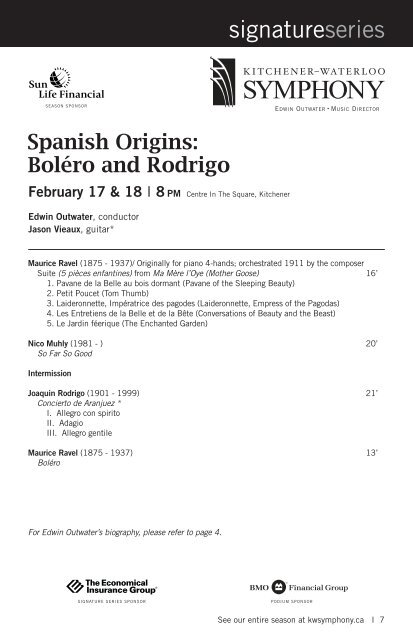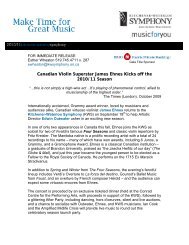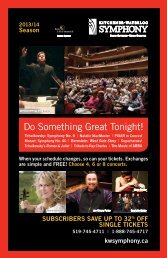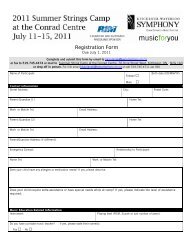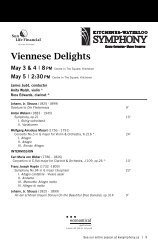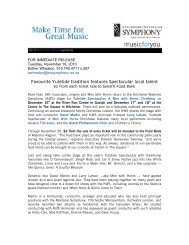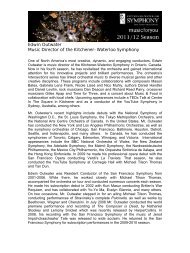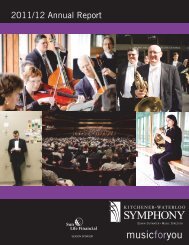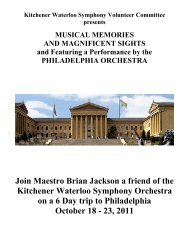Read the Program Notes - Kitchener-Waterloo Symphony
Read the Program Notes - Kitchener-Waterloo Symphony
Read the Program Notes - Kitchener-Waterloo Symphony
You also want an ePaper? Increase the reach of your titles
YUMPU automatically turns print PDFs into web optimized ePapers that Google loves.
signatureseries<br />
SEASON SPONSOR<br />
February 17 & 18 I 8 PM Centre In The Square, <strong>Kitchener</strong><br />
Edwin Outwater, conductor<br />
Jason Vieaux, guitar*<br />
Maurice Ravel (1875 - 1937)/ Originally for piano 4-hands; orchestrated 1911 by <strong>the</strong> composer<br />
Suite (5 pièces enfantines) from Ma Mère l’Oye (Mo<strong>the</strong>r Goose) 16’<br />
1. Pavane de la Belle au bois dormant (Pavane of <strong>the</strong> Sleeping Beauty)<br />
2. Petit Poucet (Tom Thumb)<br />
3. Laideronnette, Impératrice des pagodes (Laideronnette, Empress of <strong>the</strong> Pagodas)<br />
4. Les Entretiens de la Belle et de la Bête (Conversations of Beauty and <strong>the</strong> Beast)<br />
5. Le Jardin féerique (The Enchanted Garden)<br />
Nico Muhly (1981 - ) 20’<br />
So Far So Good<br />
Intermission<br />
Joaquin Rodrigo (1901 - 1999) 21’<br />
Concierto de Aranjuez *<br />
I. Allegro con spirito<br />
II. Adagio<br />
III. Allegro gentile<br />
Maurice Ravel (1875 - 1937) 13’<br />
Boléro<br />
For Edwin Outwater’s biography, please refer to page 4.<br />
SIGNATURE SERIES SPONSOR<br />
PODIUM SPONSOR<br />
See our entire season at kwsymphony.ca I 7
One of <strong>the</strong> “youngest stars of <strong>the</strong> guitar<br />
world” (New York Times, 2010), Jason Vieaux<br />
is a musician regularly noted for his engaging<br />
and virtuosic live performances, imaginative<br />
programming, and uncommon communicative<br />
gifts. Recent concert highlights include recitals<br />
for Lincoln Center and <strong>the</strong> 92nd St. Y in New<br />
York, Dumbarton Oaks in Washington DC, a debut<br />
with <strong>the</strong> Charlotte <strong>Symphony</strong>, and recitals for<br />
Spivey Hall and Indiana University. Vieaux’s<br />
2010-2011 concerto performances include works<br />
of Rodrigo, Villa-Lobos, Piazzolla and Roberto<br />
Sierra, in performances with <strong>the</strong> Chautauqua<br />
Music Festival, <strong>the</strong> symphonies of Mexico City,<br />
Ft. Worth, Grand Rapids, Illinois, Williamsburg,<br />
<strong>Read</strong>ing, Dubuque, and with Boston’s A Far<br />
Cry Chamber Orchestra. His current chamber<br />
music collaborations with <strong>the</strong> Escher Quartet,<br />
flutist Gary Schocker, and bandoneon/accordion<br />
virtuoso Julien Labro continue to display Vieaux’s<br />
extensive range of musical interests. As one<br />
of <strong>the</strong> “leading guitarists of his generation”<br />
(Absolute Sound, 2009), Jason Vieaux has<br />
established a lasting connection with his<br />
audiences, as evidenced by numerous return<br />
invitations in 2010-2011 to series in Toronto,<br />
Cleveland, Kalamazoo, Greenville (NC), and <strong>the</strong><br />
Music@Menlo festival. In October, Mr. Vieaux will<br />
receive a 2010 Salon De Virtuosi Career Grant<br />
and perform with mezzo-soprano Sasha Cooke<br />
at <strong>the</strong> Kennedy Center.<br />
Mr. Vieaux is a frequent guest with orchestras<br />
across <strong>the</strong> United States. He has performed<br />
as concerto soloist with, among many o<strong>the</strong>rs,<br />
<strong>the</strong> Cleveland Orchestra, Ft. Worth <strong>Symphony</strong>,<br />
San Diego <strong>Symphony</strong>, <strong>the</strong> Florida Orchestra,<br />
<strong>the</strong> Chamber Orchestra of Philadelphia,<br />
Orchestra 2001, IRIS Chamber Orchestra, and<br />
<strong>the</strong> Auckland Philharmonia in New Zealand,<br />
while working with such renowned conductors<br />
as Miguel Harth-Bedoya, David Robertson,<br />
Michael Stern, Jahja Ling, Stefan Sanderling and<br />
Alasdair Neale. Vieaux’s triumphant programs<br />
and collaborations for Music@Menlo, Strings<br />
Music Festival, Grand Teton, Jupiter Chamber<br />
Players, and o<strong>the</strong>rs, have forged his reputation<br />
as a first-rate chamber musician. As a passionate<br />
advocate of new music, Vieaux has premièred<br />
new pieces by Jerod Impichchaachaaha’ Tate,<br />
José Luis Merlin, Eric Sessler, Arthur Hernandez,<br />
Gary Schocker, Fazil Say, and frequently plays<br />
works by Mario Davidovsky, Roberto Sierra, and<br />
John Corigliano.<br />
Jason Vieaux has ten recordings to his credit<br />
and many more to come under his multi-record<br />
deal with Azica Records. Bach; Works for Lute,<br />
Vol.1 was released in <strong>the</strong> spring of 2009,<br />
and, after hitting #13 on Billboard’s Classical<br />
Chart after its first week, received rave reviews<br />
by Gramophone Magazine and The Absolute<br />
Sound. His previous CD, Images of Me<strong>the</strong>ny,<br />
features music by renowned American Jazz<br />
guitarist/composer Pat Me<strong>the</strong>ny. Me<strong>the</strong>ny, after<br />
listening to this landmark recording, declared:<br />
The KWS Volunteer Committee Spring Card Party<br />
Thursday, April 26th, 2012<br />
<strong>Waterloo</strong> Mennonite Brethren Church<br />
Lexington Rd, <strong>Waterloo</strong><br />
Doors open 11:30 a.m., Lunch served at noon<br />
Tickets ($20) will be available February 2012<br />
Contact Gloria Rudney for tickets: 519-742-9687<br />
8 I 2011/12 Season
iographies<br />
“I am flattered to be included in Jason’s musical<br />
world.” Sevilla: The Music of Isaac Albeniz, was<br />
rated one of <strong>the</strong> Top Ten Classical CDs of <strong>the</strong><br />
year by both The Philadelphia Inquirer and<br />
Cleveland’s Plain Dealer. Mr. Vieaux recorded<br />
his first CD when he was just 19, and two years<br />
later released <strong>the</strong> highly successful Laureate<br />
Series Guitar Recital on <strong>the</strong> Naxos label.<br />
Vieaux’s recordings and live performances are<br />
on <strong>the</strong> radio and internet; he is often heard on<br />
such top-rated programs as NPR’s “All Things<br />
Considered”, “Morning Edition”, and American<br />
Public Media’s “Performance Today”. Mr.<br />
Vieaux’s expressive and communicative gifts<br />
have been <strong>the</strong> subject of many newspaper and<br />
magazine articles around <strong>the</strong> US and abroad.<br />
Acoustic Guitar Magazine named Jason Vieaux<br />
in its January 2008 cover article The New<br />
Virtuosos as “one of three young musicians<br />
pushing <strong>the</strong> instrument beyond <strong>the</strong> traditional”.<br />
England’s MUSO and Gramophone Magazine<br />
have published feature articles on Mr. Vieaux.<br />
Jason Vieaux began guitar studies at age<br />
eight with Jeremy Sparks in Buffalo, New<br />
York, and continued study at The Cleveland<br />
Institute of Music with John Holmquist. He is<br />
<strong>the</strong> youngest First Prize winner in <strong>the</strong> history<br />
of <strong>the</strong> prestigious Guitar Foundation of America<br />
International Competition, a Naumburg<br />
International Guitar Competition prizewinner,<br />
and, in recognition of his prodigious talent and<br />
extraordinary professional career, The Cleveland<br />
Institute of Music honored Mr. Vieaux with<br />
<strong>the</strong>ir Alumni Achievement Award in 1998. In<br />
1995, Mr. Vieaux was an Artistic Ambassador<br />
of <strong>the</strong> United States to Sou<strong>the</strong>ast Asia, and<br />
concertized in Cambodia, Thailand, Laos, India,<br />
Nepal, Bangladesh, and Myanmar (Burma). He<br />
has also toured Europe, Mexico, Canada, <strong>the</strong><br />
Far East, Australia and New Zealand.<br />
Aside from his duties as a performer, Mr.<br />
Vieaux is highly dedicated to <strong>the</strong> art of teaching.<br />
He currently resides in Cleveland, Ohio, where<br />
he is Head of <strong>the</strong> Cleveland Institute of Music<br />
Guitar Department, <strong>the</strong> youngest Department<br />
Head to serve at <strong>the</strong> prestigious conservatory.<br />
He is also affiliated with Philadelphia-based<br />
Astral Artists.<br />
Jason’s website is www.jasonvieaux.com;<br />
Join <strong>the</strong> Newsletter at www.jasonvieaux.com<br />
& gift baskets<br />
Freshest Flowers<br />
Creative fresh floral designs<br />
European hand-tied bouquets<br />
Corporate accounts welcome<br />
Fruit baskets, fabulous gourmet baskets<br />
Weddings and wedding rentals<br />
Sympathy designs<br />
Volume discounts available<br />
2 Locations to serve you better<br />
After hour sympathy line: 519 721-3936<br />
28 Laurel St., <strong>Waterloo</strong><br />
Tel: 519 742-3545<br />
Toll Free: 1-866-864-4387<br />
460 Frederick St. N., <strong>Kitchener</strong><br />
Tel: 519 742-4292<br />
Toll Free: 1-800-265-0149<br />
Order online 24/7<br />
for free local delivery<br />
www.kwflowers.com<br />
For o<strong>the</strong>r great gift giving ideas,<br />
try Gifts by <strong>the</strong> Basket!<br />
www.giftsby<strong>the</strong>basket.ca<br />
See our entire season at kwsymphony.ca I 9
programnotes<br />
Maurice Ravel<br />
(1875-1937)<br />
Mo<strong>the</strong>r Goose – Suite<br />
(1908–10, orch.<br />
1911)<br />
Only <strong>the</strong> first two<br />
of <strong>the</strong> 17th century<br />
collection of French folk tales by Charles<br />
Perrault, popularly known in France as Mo<strong>the</strong>r<br />
Goose, appear in <strong>the</strong> five-movement suite that<br />
French composer Maurice Ravel first wrote for<br />
piano, four hands in 1910. The o<strong>the</strong>rs are<br />
taken from a collection published a half century<br />
later. Ravel orchestrated his Mo<strong>the</strong>r Goose in<br />
1911, magically preserving <strong>the</strong> innocence of<br />
<strong>the</strong> original, while adding colour, texture and<br />
considerable imagination. He referred to <strong>the</strong><br />
five short pieces as ‘<strong>the</strong> poetry of childhood,’<br />
with its simplified style and restrained writing.<br />
Listen for <strong>the</strong> wandering parallel, chromatic<br />
lines and mysterious bird calls as Hop-o’-mythumb<br />
is lost deep in <strong>the</strong> forest and for <strong>the</strong><br />
graceful, Satie-like waltz of Beauty and <strong>the</strong><br />
cumbersome growls of <strong>the</strong> contra-bassoon<br />
Beast.<br />
Nico Muhly (b. 1981)<br />
“So Far So Good<br />
is <strong>the</strong> first piece of<br />
non-programmatic<br />
orchestral music<br />
I’ve written in about<br />
five years. It was<br />
simultaneously thrilling and unnerving to write<br />
something without a dramatic structure helping<br />
me along. As such, <strong>the</strong> piece is sort of freeform.<br />
There are two recurring passacaglias:<br />
<strong>the</strong> first, at <strong>the</strong> beginning of <strong>the</strong> piece, a dirgelike<br />
brass drone. The second is a more flighty,<br />
chromatic affair, presented in evenly-stacked<br />
piles of woodwinds. I’m still a little frightened<br />
of <strong>the</strong> trumpet, so I wrote a nice big solo for<br />
him (or her) near <strong>the</strong> start of <strong>the</strong> piece. After<br />
<strong>the</strong>se initial expositions, we enter a sort of<br />
ma<strong>the</strong>matical ostinato-world for a few minutes.<br />
The motor of clarinets, harp, and piano carries<br />
us through several decadent harmonic spaces,<br />
but <strong>the</strong>re is perpetual motion throughout. Each<br />
cycle of ostanati is antagonized by <strong>the</strong> brass,<br />
until <strong>the</strong> piece begins to reverse itself, and we<br />
revisit earlier terrains. An extended drone in<br />
<strong>the</strong> strings and piano anchors <strong>the</strong> conclusion.”<br />
- Nico Muhly<br />
“If Muhly simply dumped his diverse musical<br />
loves into a score, he would have an eclectic<br />
mess, “ wrote The New Yorker critic Alex Ross.<br />
Nico Muhly was 22 at <strong>the</strong> time and graduating<br />
from The Juilliard School, having already<br />
picked up a degree in English Literature from<br />
Columbia University <strong>the</strong> previous year. Ross<br />
was referring to Muhly’s work as keyboardist on<br />
film and stage projects with Philip Glass, his<br />
experience singing in a boys’ choir (which led to<br />
a commission from <strong>the</strong> choir of Clare College,<br />
Cambridge <strong>the</strong> following year), and an iPod<br />
loaded with <strong>the</strong> likes of Björk, Múm, Ladytron,<br />
and Fischerspooner. Targeting Muhly, born in<br />
Vermont in 1981 and raised in Providence,<br />
Rhode Island, for “a major career,” Ross was<br />
impressed by a score that Muhly wrote as a<br />
student, in 2004, for <strong>the</strong> annual concert of <strong>the</strong><br />
Juilliard Orchestra.<br />
10 I 2011/12 Season
Since <strong>the</strong>n, Muhly’s career has rapidly<br />
advanced, with a concert of his music at<br />
Carnegie Hall, several recordings, including<br />
From Here On Out with <strong>the</strong> KWSO, and many<br />
commissions.<br />
Joaquin Rodrigo<br />
(1901-1999)<br />
Concierto de<br />
Aranjuez, for guitar<br />
and orchestra (1939)<br />
The music of Spanish<br />
composer Joaquin<br />
Rodrigo travels well<br />
beyond <strong>the</strong> Aranjuez<br />
of his earliest and bestknown<br />
concerto, written in 1939. His long<br />
journey (he was 98 when he died) took him<br />
through 170 compositions in many genres, 11<br />
of which are concertos. He wrote <strong>the</strong> Concierto<br />
de Aranjuez not long after returning from studies<br />
in France, newly wedded to Victoria Kamhi who<br />
would help <strong>the</strong> blind composer both personally<br />
and professionally throughout his life. She said<br />
that <strong>the</strong> haunting, gently melancholy <strong>the</strong>me of<br />
<strong>the</strong> slow movement recalls “<strong>the</strong> happy days of<br />
our honeymoon, when we walked in <strong>the</strong> park<br />
in Aranjuez, and at <strong>the</strong> same time, it is a love<br />
song.” For most of us, this magnificent <strong>the</strong>me,<br />
first heard on cor anglais, is <strong>the</strong> archetypal<br />
Spanish <strong>the</strong>me and <strong>the</strong> work itself, likely <strong>the</strong><br />
best-known concerto for any instrument from<br />
<strong>the</strong> last century.<br />
Maurice Ravel (1875-<br />
1937)<br />
Boléro (1928)<br />
“I have written only<br />
one masterpiece<br />
and that is Boléro,”<br />
Ravel sardonically<br />
told a fellow<br />
composer. “Unfortunately, it contains no<br />
music.” First written as a ballet score in 1928<br />
for Ida Rubinstein’s troupe, Boléro builds<br />
continuously on just one rhythm and a single<br />
<strong>the</strong>me in two sections. The piece evolves as<br />
a huge orchestral crescendo created primarily<br />
through constantly expanding orchestral<br />
timbre. “It is an experiment in a very special<br />
and limited direction,” Ravel cautioned when<br />
<strong>the</strong> piece began to be popular and to receive<br />
performances in <strong>the</strong> concert hall. [It consists<br />
solely of] “orchestral tissue without music –<br />
of one long, very gradual crescendo. . . The<br />
<strong>the</strong>mes are impersonal – folk-tunes of <strong>the</strong> usual<br />
Spanish-Arabian kind.” This use of <strong>the</strong> word<br />
‘impersonal’ is reflected in Ravel’s original<br />
conception of <strong>the</strong> stage design of Boléro as a<br />
streetscape, with a factory in <strong>the</strong> background.<br />
Like Honegger’s tone-poem Pacific 231, early<br />
20th century life is reflected in art, specifically<br />
in Ravel’s hypnotic, machine-like rhythmic<br />
repetitions.<br />
– <strong>Notes</strong> © Keith Horner, 2011. Comments<br />
welcomed: keith.horner@sympatico.ca<br />
ADVANCE NOTICE FROM THE KWS<br />
VOLUNTEER COMMITTEE<br />
14th-Annual House and<br />
Garden Tour of Note<br />
Saturday, June 9, 2012 -<br />
MARK YOUR CALENDARS!<br />
Six fantastic homes and gardens for you<br />
to enjoy. Tickets will be available in May.<br />
Please watch for updated notices at www.<br />
kwsymphony.ca/housetour/index.php for<br />
information about <strong>the</strong> Tour, including<br />
where to purchase tickets.<br />
See our entire season at kwsymphony.ca I 11


